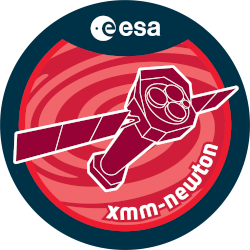

| Proposal ID | 065305 |
| Title | The Physics of Cosmic Shocks: The NW Merger Shock and Radio Relic in Abell 3667 |
| Download Data Associated to the proposal | https://nxsa.esac.esa.int/nxsa-sl/servlet/data-action-aio?obsno=0653050201 |
| DOI | https://doi.org/10.5270/esa-af6n2kd |
| Principal Investigator, PI | Prof Craig Sarazin |
| Abstract | Abell 3667 is the archetype of a merging cluster with radio relics. The NW relicis the brightest cluster relic or halo known. This region was imaged with XMM inAO-7. We detected a X-ray brightness and hardness jump at the edge of the NWrelic. This could be due to a merger shock, or to inverse Compton (IC) emissionfrom the relic; both are consistent within the errors. We propose a longobservation to determine the contributions of shock and IC emission. Comparisonof the shock properties and the radio relic will be a critical test of the shockacceleration model for relics. The relic IC emission will give the magneticfield and cosmic ray energy of the relic. We will determine the efficiency ofparticle acceleration, and provide the first data on the physics of cosmic shock fronts. |
| Publications |
|
| Instrument | EMOS1, EMOS2, EPN, OM, RGS1, RGS2 |
| Temporal Coverage | 2010-09-21T13:29:42Z/2010-11-03T09:22:37Z |
| Version | 17.56_20190403_1200 |
| Mission Description | The European Space Agencys (ESA) X-ray Multi-Mirror Mission (XMM-Newton) was launched by an Ariane 504 on December 10th 1999. XMM-Newton is ESAs second cornerstone of the Horizon 2000 Science Programme. It carries 3 high throughput X-ray telescopes with an unprecedented effective area, and an optical monitor, the first flown on a X-ray observatory. The large collecting area and ability to make long uninterrupted exposures provide highly sensitive observations. Since Earths atmosphere blocks out all X-rays, only a telescope in space can detect and study celestial X-ray sources. The XMM-Newton mission is helping scientists to solve a number of cosmic mysteries, ranging from the enigmatic black holes to the origins of the Universe itself. Observing time on XMM-Newton is being made available to the scientific community, applying for observational periods on a competitive basis. |
| Creator Contact | https://www.cosmos.esa.int/web/xmm-newton/xmm-newton-helpdesk |
| Date Published | 2011-11-30T00:00:00Z |
| Last Update | 2025-08-04 |
| Keywords | "brightest cluster relic", "hardness jump", "shock properties", "XMM", "radio relics", "merger shock", "magnetic field", "cosmic shoc", "particle acceleration", "nw merger shock", "xray brightness", "cosmic shock fronts", "abell 3667", "ic emission", "merging cluster", "shock acceleration model", "nw relic", "radio relic", "relic ic emission", "Abell 3667", "cosmic ray energy" |
| Publisher And Registrant | European Space Agency |
| Credit Guidelines | European Space Agency, Prof Craig Sarazin, 2011, 'The Physics of Cosmic Shocks: The NW Merger Shock and Radio Relic in Abell 3667', 17.56_20190403_1200, European Space Agency, https://doi.org/10.5270/esa-af6n2kd |